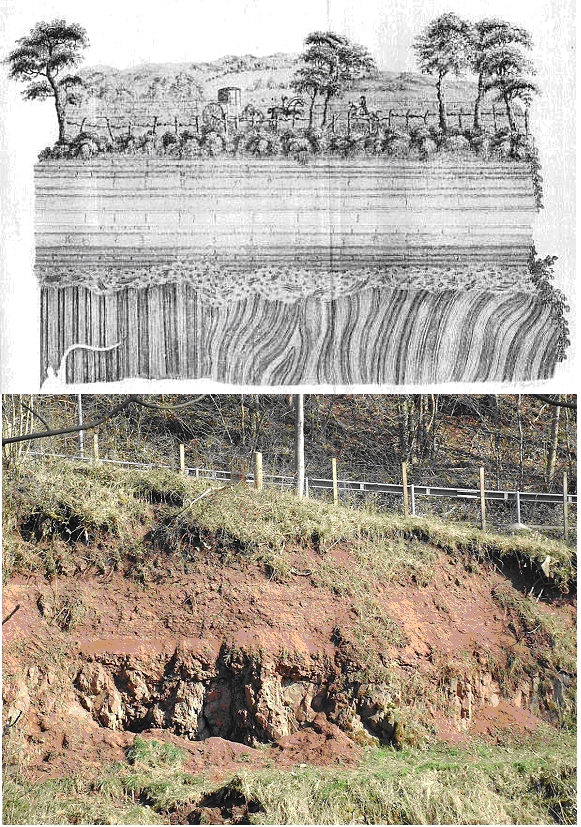Hutton’s Unconformity is a critical geological site that played a pivotal role in the development of modern geology. Named after James Hutton, the 18th-century Scottish geologist, the site near Jedburgh is one of the key locations where Hutton formulated his groundbreaking ideas about the Earth’s history and geological processes.
James Hutton and His Contributions
James Hutton (1726-1797) is often referred to as the “Father of Modern Geology.” His observations and theories laid the foundation for understanding the Earth’s geological processes over vast periods of time, a concept known as “deep time.” Hutton proposed the theory of uniformitarianism, which posits that the same natural processes observed today, such as erosion and sedimentation, have been occurring throughout Earth’s history at similar rates. This was a radical departure from the prevailing view of his time, which often attributed geological formations to catastrophic events and a much shorter Earth history.
Hutton’s Unconformity Explained
An unconformity is a surface within a sequence of layers of sedimentary rock where new rock layers were deposited on top of older, eroded rock layers, indicating a significant gap in the geological record. Hutton’s Unconformity near Jedburgh is a classic example of such a feature.
Location and Description:
- Geographical Setting: Hutton’s Unconformity is located along the banks of the Jed Water, near the town of Jedburgh in the Scottish Borders. It is a short walk from the town center and is accessible to visitors interested in geology and history.
- Rock Layers: At the Jedburgh site, visitors can observe nearly vertical layers of older, greywacke sandstone from the Silurian period, which are overlain by much younger, more gently sloping layers of red sandstone from the Devonian period.
Geological Significance
Hutton’s observations at this site were crucial in supporting his theory of deep time. The key aspects of Hutton’s Unconformity that demonstrate his theories include:
Vertical and Horizontal Layers:
- Older Rock: The nearly vertical greywacke sandstone layers, which were originally laid down horizontally and then tilted and eroded over time.
- Younger Rock: The horizontal red sandstone layers that were deposited on top of the eroded surface of the older rocks.
Erosion and Deposition:
- Erosion: The vertical greywacke layers show evidence of significant erosion before the younger sandstone layers were deposited. This erosion indicates a long period during which the older rocks were exposed to weathering and erosion.
- Deposition: The younger horizontal sandstone layers indicate a period of new sediment deposition that occurred long after the older rocks had been formed and eroded.
Historical Impact
Hutton’s interpretation of this site provided strong evidence for the concept of an ancient Earth shaped by slow, continuous processes. His observations contradicted the then-dominant view of a young Earth shaped by catastrophic events. Instead, Hutton proposed that the Earth was much older than previously thought and that its landscapes were shaped by gradual processes still observable today.
Theory of Uniformitarianism: Hutton’s principle of uniformitarianism, often summarized as “the present is the key to the past,” posits that by understanding current geological processes, we can interpret the geological history recorded in rock formations.
Visiting Hutton’s Unconformity
Hutton’s Unconformity at Jedburgh is a must-visit for geology enthusiasts and those interested in the history of science.
Site Accessibility:
- Directions: The site is located along the banks of the Jed Water, accessible via a footpath from the town of Jedburgh.
- Signage: Informative panels at the site explain the significance of the unconformity and provide context for Hutton’s discoveries.
Educational Value:
- Field Trips: The site is often used for educational purposes, with geology students and scholars visiting to study the unconformity firsthand.
- Public Interest: Interpretive tours and educational programs help visitors understand the importance of the site and its impact on geology.
Conclusion
Hutton’s Unconformity near Jedburgh is a landmark of immense geological and historical significance. It not only provided key evidence for James Hutton’s revolutionary ideas about Earth’s geological processes and the concept of deep time but also continues to serve as an educational and inspirational site for visitors. Hutton’s work at this site fundamentally changed our understanding of the Earth’s history, marking a crucial development in the field of geology.
